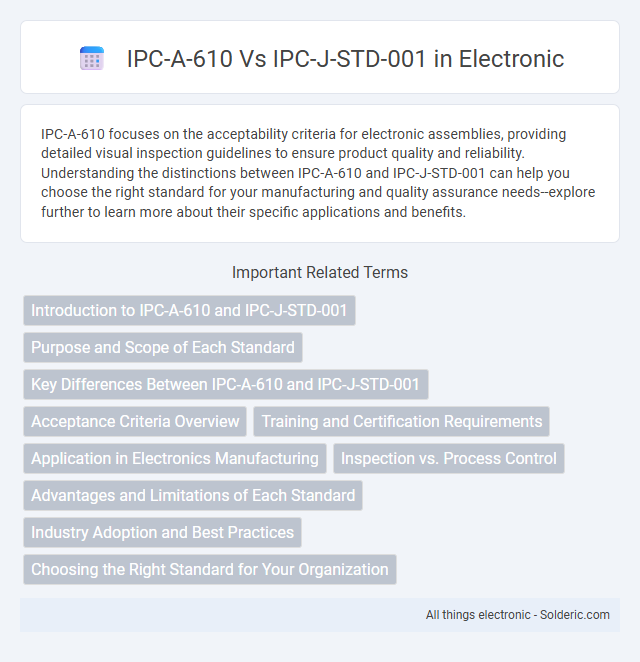IPC-A-610 focuses on the acceptability criteria for electronic assemblies, providing detailed visual inspection guidelines to ensure product quality and reliability. Understanding the distinctions between IPC-A-610 and IPC-J-STD-001 can help you choose the right standard for your manufacturing and quality assurance needs--explore further to learn more about their specific applications and benefits.
Comparison Table
| Aspect | IPC-A-610 | IPC-J-STD-001 |
|---|---|---|
| Purpose | Acceptability requirements for electronic assemblies | Requirements for soldered electrical and electronic assemblies |
| Scope | Inspection criteria for assembled printed circuit boards (PCBs) | Materials, processes, and workmanship standards for soldering |
| Key Focus | Visual quality and acceptability of completed assemblies | Process control and soldering workmanship methodology |
| Users | Inspectors, quality control, production teams | Operators, assemblers, process engineers |
| Document Type | Acceptance criteria standard | Material and process specification |
| Revision Frequency | Updated periodically (latest IPC-A-610G as of 2024) | Updated periodically (latest IPC-J-STD-001N as of 2024) |
| Application | Final product inspection and quality assurance | Manufacturing process control and certification |
Introduction to IPC-A-610 and IPC-J-STD-001
IPC-A-610 is the leading standard for the acceptability of electronic assemblies, providing detailed criteria for quality inspection in manufacturing to ensure reliable and consistent product outcomes. IPC-J-STD-001 focuses on requirements for soldered electrical and electronic assemblies, emphasizing materials, processes, and workmanship essential for high-reliability solder joints. Both standards serve complementary roles in electronic manufacturing by establishing rigorous guidelines for assembly quality and process control.
Purpose and Scope of Each Standard
IPC-A-610 establishes acceptability requirements for electronic assemblies, focusing on visual inspection criteria to ensure high-quality workmanship in finished products. IPC-J-STD-001 defines requirements for soldered electrical and electronic assemblies, emphasizing materials, methods, and process controls for consistent solder joint quality. Both standards serve complementary roles in electronics manufacturing by addressing assembly acceptability and soldering process standards, ensuring overall product reliability and performance.
Key Differences Between IPC-A-610 and IPC-J-STD-001
IPC-A-610 sets the standard for the acceptability of electronic assemblies, emphasizing product quality and visual inspection criteria, while IPC-J-STD-001 focuses on materials, processes, and workmanship requirements for soldered electrical and electronic assemblies. The key difference lies in IPC-A-610 being a product acceptance standard primarily used by inspectors and IPC-J-STD-001 serving as a process standard guiding manufacturers on acceptable soldering techniques and material handling. IPC-J-STD-001 includes detailed requirements on soldering-related aspects such as thermal profiles and contamination control, which IPC-A-610 references for final product quality assessment.
Acceptance Criteria Overview
IPC-A-610 defines acceptability criteria for electronic assemblies focusing on workmanship standards and visual inspection requirements to ensure product quality. IPC-J-STD-001 details requirements for soldered electrical and electronic assemblies, emphasizing solder joint integrity, material specifications, and process control for consistent reliability. Together, they establish comprehensive acceptance criteria by addressing both visual quality standards and functional soldering processes in electronics manufacturing.
Training and Certification Requirements
IPC-A-610 focuses on the acceptance criteria for electronic assemblies and requires specialized training for inspectors to accurately assess product quality. IPC-J-STD-001 emphasizes the requirements for soldered electrical and electronic assemblies, with mandatory certification for assemblers and inspectors to ensure compliance with soldering standards. Your team's certification in both standards enhances proficiency in quality control and assembly processes, ensuring adherence to industry best practices.
Application in Electronics Manufacturing
IPC-A-610 provides detailed acceptance criteria for electronic assemblies, focusing on quality standards and inspection requirements in electronics manufacturing. IPC-J-STD-001 outlines the process requirements for soldered electrical and electronic assemblies, emphasizing materials, methods, and workmanship for reliable solder joints. Both standards are essential in electronics manufacturing, with IPC-A-610 guiding inspection and IPC-J-STD-001 governing soldering processes.
Inspection vs. Process Control
IPC-A-610 provides detailed criteria for the inspection and acceptability of electronic assemblies, emphasizing visual quality standards and workmanship requirements. IPC-J-STD-001 focuses on process control by specifying materials, methods, and performance requirements needed to ensure reliable soldered electrical and electronic assemblies. Together, IPC-A-610 guides inspection decisions while IPC-J-STD-001 governs the manufacturing processes to achieve consistent quality.
Advantages and Limitations of Each Standard
IPC-A-610 offers detailed acceptability criteria for electronic assemblies, providing clear visual standards that simplify quality inspections and ensure consistent product reliability. IPC-J-STD-001 emphasizes material and process requirements for soldered electrical and electronic assemblies, promoting improved solder joint integrity and enhanced manufacturing reliability. Your choice depends on whether you prioritize comprehensive inspection criteria (IPC-A-610) or stringent fabrication process controls (IPC-J-STD-001).
Industry Adoption and Best Practices
IPC-A-610 is widely adopted in the electronics manufacturing industry for its detailed acceptance criteria and visual standards to ensure high-quality solder joints and assemblies. IPC-J-STD-001 complements this by providing comprehensive requirements for materials, processes, and workmanship, establishing best practices for soldering electronics components. Together, these standards form the foundation for quality control and process consistency across PCB assembly and rework operations in aerospace, automotive, and consumer electronics sectors.
Choosing the Right Standard for Your Organization
Selecting the appropriate standard between IPC-A-610 and IPC-J-STD-001 depends on your organization's requirements for electronic assembly acceptability versus soldering process control. IPC-A-610 provides detailed criteria for the acceptability of electronic assemblies, making it ideal for quality inspection and final product validation. IPC-J-STD-001 emphasizes soldering process and material requirements, supporting robust manufacturing practices and ensuring solder joint reliability in your production line.
IPC-A-610 vs IPC-J-STD-001 Infographic

 solderic.com
solderic.com